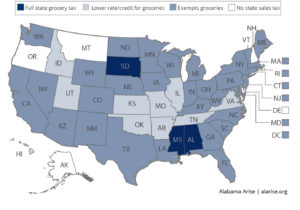Voting rights are a flashpoint in Alabama’s history. The long denial of those rights to African Americans led to Bloody Sunday in Selma, the march to Montgomery and eventually passage of the Voting Rights Act of 1965. In the half-century since, our state has taken a few steps that increase voting access for communities of color. But our system remains cumbersome and expensive. Automatic voter registration (AVR) would be a major step toward bringing our state’s system into the 21st century.
Before every major election in Alabama, a surge of activity focuses on voter rolls. For people seeking to exercise one of the most basic rights of democracy, getting registered and keeping that registration current can fall prey to busy schedules and confusing rules. Signing up eligible voters and ensuring lists are up-to-date are important responsibilities that cost Alabama advocates, civic groups and state officials a considerable amount of time and money.
There is a better way. Since 2015, sixteen states (including Georgia) and the District of Columbia have approved AVR, according to the Brennan Center for Justice. AVR registers eligible people when they apply for a driver’s license or share information with agencies in other routine ways. (People who do not want to register can opt out.) AVR saves money and removes barriers to civic participation.
A common-sense change
Voter registration in Alabama is outdated. In many places, the state uses the same pen-and-paper methods in operation for more than a century. Registering voters this way requires paying for printing, postage and staff to process the forms. If a person moves, the process is repeated, with those costs paid again. Some counties do conduct registration electronically. That requires less paper, but the kiosks are a considerable expense and still require staff.
Alabama could have saved about $2 million a year since 2015 by automatically registering all voters, according to estimates based on Oregon’s registration costs. Registering a new voter or updating records cost $7.67 per transaction in 2008, according to an Oregon study by the Pew Center on the States. But using data that agencies already have to register that voter automatically would have cost just 3 cents, Pew found. In Alabama, more than 1 million people have registered to vote since January 2015.
Building on previous gains
Alabama already offers voter registration services at several state agencies. The National Voter Registration Act of 1993 (aka “Motor Voter Act”) requires states to give people the chance to register to vote when they apply for a driver’s license. It also requires state agencies that provide public assistance, or that offer state-funded programs primarily engaged in providing services to people with disabilities, to offer voter registration services. Armed forces recruiting stations must provide registration services, and states must designate additional agencies of their choice to do so as well. Registering all eligible citizens automatically would increase the efficiency of a task the state already performs.
AVR would save time for citizens and public agencies across Alabama. Automatically registering people electronically would be less costly and time-consuming than processing paper forms. AVR also would build on Alabama’s recent improvements to streamline voter registration at Department of Motor Vehicles (DMV) offices. Those important changes have made it faster and easier for Alabamians to register to vote, but making registration automatic (with an opt-out choice for people who don’t want to register) would make it even faster and even easier. AVR would save people time at the courthouse. More importantly, it would encourage civic engagement by breaking down barriers to voting.
Civic boost, lower cost
Just 50 percent of people registered to vote in Alabama did so in the 2018 general election – and even that turnout exceeded expectations. Low voter participation weakens democracy in our state. People who don’t vote are less likely to be engaged in their communities in other ways, and less likely to feel their voices are heard.
Other states have seen significantly higher voter participation after implementing AVR. Georgia, which put AVR in place before the 2016 election, saw voter turnout increase 11.4 percent from 2014 to 2018. By taking similar steps to remove paperwork barriers to democracy, Alabama can increase the number of people who participate in electing government officials.
Many states with AVR have seen large cost savings as well. For example, Oregon used AVR in 2016 to re-register 35,000 people with lapsed registrations and to register more than 220,000 people overall. Those moves saved an estimated $264,400 and $1.7 million, respectively, compared to doing so by hand.
AVR would be a cost-effective way to register, re-register or update voter registrations for hundreds of thousands of Alabamians. Alabama has nearly 300,000 voters on the inactive voter list, plus tens of thousands of people who are eligible but not yet registered. AVR would get those folks on the voter rolls at a much lower cost than traditional paper registration. It also offers a more efficient way to update records for people who have moved or changed their name. The money saved through AVR could be used to meet a range of other needs in Alabama. That could include expanding opportunities in underfunded schools, improving aging infrastructure or providing state funding for public transportation.
How to implement AVR
Alabama shouldn’t wait for federal action to boost civic participation. Three big policy choices could decide the scope of state-level AVR here:
— Legislative or administrative? Alabama can implement AVR through the Legislature or administrative rulemaking. States have used both options for automatic registration. Legislative implementation, used in most states, allows more input from elected officials in decision-making. Rulemaking can have a quick turnaround. Georgia, for example, conducted its rulemaking in 2016 and implemented AVR the same year.
— DMV-only or through all agencies? Every state with AVR, other than Alaska, uses its DMV to register voters, according to the Brennan Center. DMV implementation requires only one agency to modernize its procedures, and DMV users are a broad cross-section of society. But DMV-only implementation is likely to leave out many seniors, people with disabilities, and other people who are less likely to drive. Because DMV registration does not serve some people, some states offer automatic registration at other agencies as well.
— Pre-registration for citizens under age 18? Twenty-two states and the District of Columbia allow citizens to pre-register to vote before their 18th birthdays. Automating pre-registration would reduce paperwork and allow more young Alabamians to participate in democracy.
Bottom line: AVR by 2020
As our state enters its third century, Alabama should launch a new era of strengthened voting rights by implementing automatic voter registration in time for the 2020 general election. AVR would cut red tape, save taxpayers millions of dollars a year and, most importantly, increase participation in the democratic process. Ensuring everyone’s voice is heard is an essential step toward building a better Alabama for all.

 Sales taxes are especially regressive in Alabama, because they apply to many kinds of spending that are not optional.
Sales taxes are especially regressive in Alabama, because they apply to many kinds of spending that are not optional.